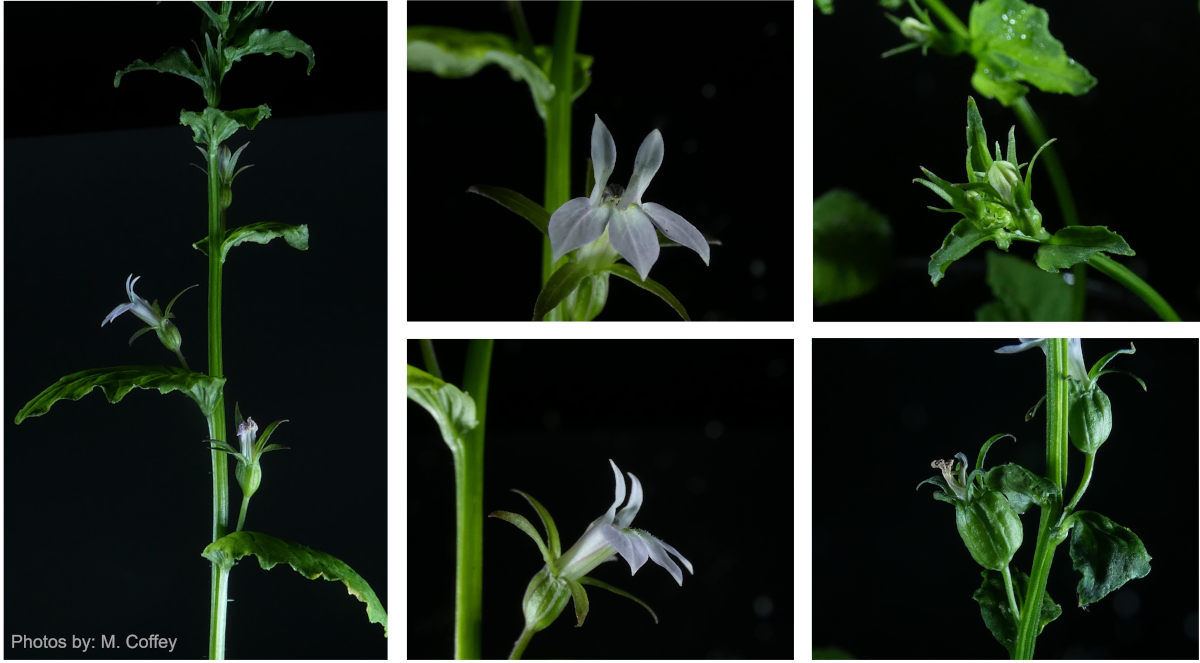
Research Project:
The evolution of floral mating system in members of the genus Lobelia.
My research explores the evolution of within-species variation in mating system in members of the genus Lobelia. Specifically, I focus on one species: Lobelia inflata (common name: Indian Tobacco or Pukeweed). L. inflata is a biennial herbaceous Lobelia species which produces small white/periwinkle/purple flowers that develop into the inflated capsule fruit from which its specific epithet is derived. It can be found across much of Eastern North America; from Alabama and Georgia all the way up into southern Quebec and the Maritimes. In previous microsatellite work done in our lab, populations of L. inflata from around the Ottawa area were found to be completely selfing (>99% homozygosity at 22 microsatellite loci) (Hughes & Simons 2015). My research focuses on why L. inflata is completely selfing, whether there exists within-species variation in its mating system, how its mating system is influenced by floral morphology and development, and the consequences that this reproductive strategy has for the species.

Research Questions and Projects:
A) Is there geographic variation in mating system in L. inflata?
- Given that the completely selfing populations of L. inflata occur near the species’ northern range margin, we hypothesized that they may be an extreme of a latitudinal trend in selfing which has resulted from selection for high self-fertilization under mate limitation near species range margins.
- Using iNaturalist community science images, we tracked evidence of stylar exsertion, a proxy measure of outcrossing capacity in L. inflata, across its species range and found that evidence for the ability of L. inflata to outcross increased in the south of its range and near the proportional range centre. This indicates that outcrossing rates may also increase in the south and closer to the range core.
- Video Link: https://youtu.be/oJWFbrk8rrw
Citation: Coffey, M. L. & Simons, A.M. Latitudinal trends in mating system in the highly self-fertilizing Lobelia inflata revealed by community science. “Manuscript submitted for publication”
B) Does within-species variation in Lobelia inflata mating system result from environmental factors?
- We have identified that L. inflata demonstrates a latitudinal trend in outcrossing capacity. However, geography alone (i.e., latitude) is not the sole factor which can result in selection for high selfing rates. Environmental factors like climatic and anthropogenic effects can also lead to selection for increased selfing.
- Therefore, we wish to know the extent to which factors like climate (i.e., temperature, precipitation) and human land-use (urban and agricultural) explain the geographic variation in stylar exsertion, on top of latitude, that we found using iNaturalist community science data. In this way, we can determine if mating system variation is purely geographic or if it may be explained by variation in environmental conditions.
C) Has Lobelia inflata retained protandry?
- Typical Lobelias are protandrous, they demonstrate a temporal separation of androecium (stamens) and gynoecium (pistil) development and maturity. In Lobelias, the transition from staminate to pistillate phase is marked by exsertion of the style from the flower’s fused stamen tube. This is thought to promote outcrossing by reducing the interaction between self-pollen and the stigmatic surface. However, in L. inflata, complete selfing results from a lack of stylar exsertion; the only pollen accessible to the stigma is self-pollen from within the stamen tube.
- It is unknown if during this transition to complete self-fertilization L. inflata has retained protandry given that the events of floral development occur hidden within the stamen tube. Does pollen still mature before the stigma lobes? Or do androecium and gynoecium maturity now overlap?
D) To what extent does variation in floral protandry affect outcrossing rates?
- The separation of floral sexual phases in typical protandrous Lobelia species is thought to limit self-fertilization. However, to what extent does variation in the length of separation effect outcrossing rates?
- In this project my aim is to quantify variation is sexual phase length (the time difference between staminate and pistillate phases) on the outcrossing rate of individual flowers. If the timing of separation is an important factor, flowers that have the greatest separation of sexual phases should demonstrate the greatest outcrossing rates.
Side Project(s):
A) Ruby-Throated Hummingbird abundance and sexual phase length in Cardinal Flower
- Lobelia cardinalis (Cardinal Flower) is one of the most famous North American Lobelia species producing brilliant red flowers which are pollinated solely by the only hummingbird species found in much of Eastern North America: Archilochus colubris (Ruby-Throated Hummingbird). Devlin and Stephenson (1984) found that in L. cardinalis protandrous floral phase length was influenced by A. colubris activity – staminate phase shortened under frequent visitation and high pollen removal.
- I want to know if sexual phase length in natural L. cardinalis populations varies based on the relative abundance of A. colubris in the area – i.e., do individuals occurring in low abundance areas show lengthened staminate phases?